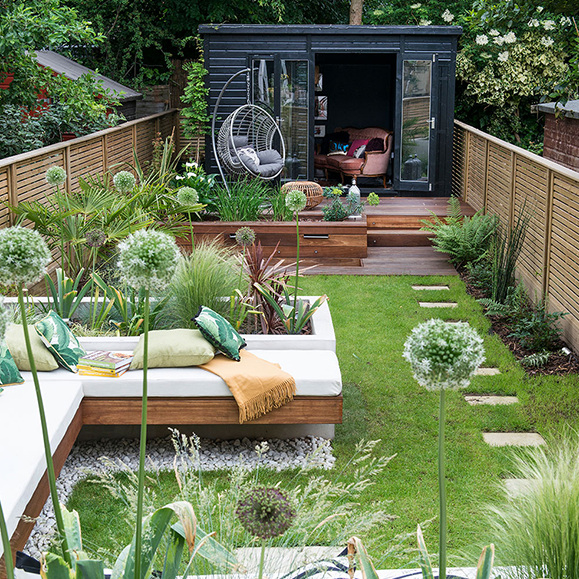Planning And Designing A Mini Garden
In the city in particular, plots of land with tiny gardens are becoming increasingly common. When designing such mini gardens, it is particularly important to structure clearly and plan carefully. This is how you turn a small garden into an oasis of well-being.
A mini garden can be turned into a small oasis with a water basin and seating area.
How to create a mini garden This question comes up more and more often, especially in cities, because the gardens are getting smaller and smaller with rising property prices. Often there are only a few meters between the terrace and garden fence to the neighbour or the street, which makes an attractive design difficult. But if you plan your mini garden well and follow a consistent concept, you can create a real paradise on 50 square meters or less.
Collapsible content

Planning a mini garden
Before you start planting, it is important to come up with a concept for the design of the mini garden. You should first consider the main purpose of the garden and what style you prefer. A playground for dogs and children has different requirements than a flowery oasis of calm or a cozy seating area for convivial coffee groups. Also keep in mind that the style of the house - whether modern, Victorian, simple, playful or rustic - is very dominant on cramped lots. So design the garden to match the architectural style. You may even be able to pick up colors and materials from the facade, balconies or wood paneling from the living room or kitchen in the garden and thus create a harmonious overall picture.Rose arches and a privacy fence make the small seating area a cozy feel-good space.
Room layout in the mini garden
The most important point when designing a mini garden is a well-thought-out room layout. Especially in small gardens, it makes sense not to design the space completely open and only to plant plants on the edges, but to create individual semi-open spaces with privacy screens, narrow hedges or rose arches , which arouse the viewer's curiosity and the garden through the slightly winding make the structure appear larger. Avoid large lawns in mini gardens, because these tend to appear compressed on a small area and have little creative use. Instead, create seating areas, paths, possibly a play area and a water point. The different areas occupy the eye and distract from the small garden size.
A privacy screen ensures privacy
Good privacy protection is essential, especially in small gardens , because city gardens are usually framed by neighboring houses. In order to create a cozy retreat in a small space, you should use green walls or narrow hedges if possible. The garden already appears lively at the outer edge. Plant climbing plants on house walls, privacy screens or fences or set narrow hedges that should not be too high. A good way to loosen up the restrictive effect of privacy screens is to use different heights or only individual elements instead of erecting an entire fence.
Paths and coverings in the mini garden
Depending on which design you prefer, you can create garden paths that are straight and symmetrical or curved and playful. In a small garden, it is important to consistently adhere to the form and limit it to one or two axes. Even if a garden path does not seem necessary on a small plot, it visually stretches the garden considerably! When implementing straight paths in the mini garden, we recommend a short path to a paved area with rough stoneslabs , a statue, standard trees, a seat, a swing seat or another focal point that is framed by beds and bushes.
Curved paths make small gardens appear larger overall. However, you should not plan too many windings here, otherwise the whole thing will come across as rather compact. Use the same or similar materials for the path as for the terrace, possibly in a smaller version, because the size effect is much better when made from one piece. Light stones and pebbles visually open up the room and look particularly elegant.
Choose harmonious colors and shapes
As with the paths, there are two main design variants for bed shapes and seating areas: square or round. Round and semi-circular areas are well suited to bringing a certain dynamic to the garden design and make long, narrow plots of land appear more harmonious. Due to their simplicity and uniformity, strictly symmetrical mini-gardens appear larger and more open, but less playful. The color scheme also plays a major role in the planning of mini gardens. Colorful beds are lush and lavish, but can quickly become overwhelming in a small space. Rather limit yourself to a few main colors that you pick up in all beds. Combinations with white have proven particularly effective in the design of small rooms, as the brightness of the flowers opens up the space.
Plant selection for small gardens
It goes without saying that there is no space for large trees in a mini garden. However, you do not have to do without a fruit tree even in small gardens. China oranges, Cheeku, Fig, Pomegranate and lemon are suitable for the mini garden.
When planting beds, it is advisable to limit yourself to a few types of flowering plants and to repeat them at intervals. This creates a clear, harmonious garden image. In between, you can play with ornamental leaf plants and filigree ornamental grasses, which give the planting fullness without appearing restless.
Water in the mini garden
A good solution to add dynamism to a very small garden is a small stream , fountain or water feature . Very small ponds usually miss their effect in the mini garden, as they often resemble ponds and have little decorative use. It is therefore better to use a source stone, a small fountain or a space-saving wall waterfall. It is important in a small garden that the water moves, because flowing water exudes liveliness and atmosphere. Even small streams are a good solution for mini gardens. They do not take up much space, but their shape visually lengthens the garden area.
Decorate mini garden
When it comes to decorating a small garden, less is more. Decide on two or at most three materials that you reuse in different places. A single eye-catcher such as a statue, a fountain, a herb spiral or similar is sufficient in the mini garden. Do not overload the small area with decorative objects, because these small items quickly appear untidy and cluttered. A well thought-out lighting concept with just a few prominent focal points (e.g. an illuminated source stone or ornamental grass illuminated from below) gives small gardens a great flair, even in the evening.

